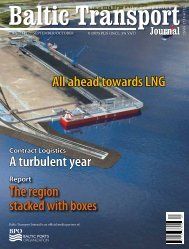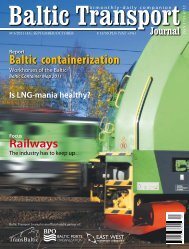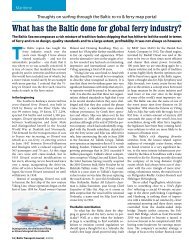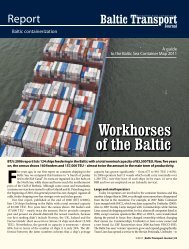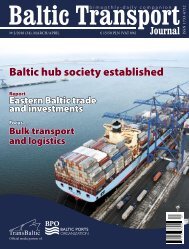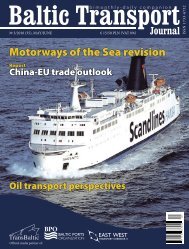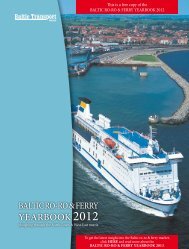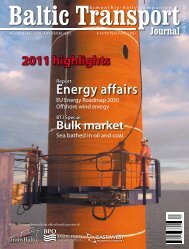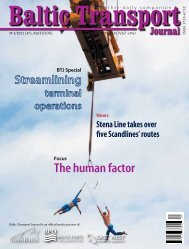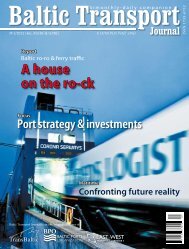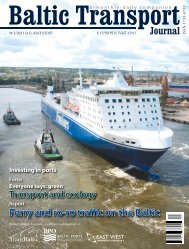Create successful ePaper yourself
Turn your PDF publications into a flip-book with our unique Google optimized e-Paper software.
The cost of these port investments is estimated at EUR 313.7m, but the<br />
expenditure for the whole project, with road connections, railway line, fairway<br />
and logistics centres amounts to well over EUR 600m. The participants in<br />
the project are: the Port of Helsinki (the constructor of Vuosaari), the Finnish<br />
Road Administration, the Finnish Rail Administration and the Finnish Maritime<br />
Administration. The ownership of the entire traffic connections will be<br />
the governmental participants.<br />
A logistics area is planned for construction in the vicinity of the Vuosaari<br />
harbour. It will consume about 75 hectares of land, of which 50 will<br />
serve as a logistics hinterland for the port. Apart from the logistics centre,<br />
a business park is anticipated to be built in order to further increase the<br />
attractiveness of the area.<br />
Economy<br />
The Vuosaari harbour will offer the most frequent shipping services between<br />
Finland and the north-central European ports. The total capacity of<br />
the port will amount to 12m tons (2m more than is currently handled by the<br />
Port of Helsinki). The construction of the harbour will not change any shipping<br />
routes on the <strong>Baltic</strong> Sea and the Finnish Bay as the new site will have the<br />
same functions as the old port in the centre of the city. However, centralizing<br />
the harbour activities will enable cost-savings and, at the same time, increase<br />
the efficiency of port operations and transportation. According to the Port of<br />
Helsinki, the harbour traffic will be organised in such a way that a trailer truck<br />
can pick up a container at the harbour within a couple of minutes. The new<br />
port is already gaining attention from business entities. A letter of agreement<br />
has been signed with Finnsteve Oy Ab, Steveco and Multi-Link Terminals<br />
Ltd. – all first class players in cargo handling, stevedoring and forwarding.<br />
Furthermore, the Vuosaari Harbour, the nearby logistics centre, and business<br />
park will create around 4,000 new jobs. This will definitely have an impact on<br />
the development of the district and of the city centre.<br />
Spatial aspect<br />
Relocation of the port and industrial activities is a result, as said before, of<br />
the change in technology and demand. For the last decades we have noticed<br />
this process on the continent and the British Aisles, e.g. in Baltimore, London,<br />
Copenhagen and Cardiff. The list is too long to enumerate all. What we must<br />
keep in mind is the balance of gains and losses. Helsinki is a very “lucky” city<br />
– by having an extremely long shoreline the town has ample space for the shift<br />
of its industrial activities to much more favourable sites.<br />
When the harbour operations are transferred to Vuosaari, the West and<br />
North Harbours may, and supposedly will be, used for commercial and residential<br />
functions. New homes, offices, and waterside parks will become reality.<br />
In the Länsisatama (West Harbour) and Sörnäinen (North Harbour) flats<br />
for approximately 20,000 to 30,000 residents will be built, and the area of<br />
Sörnäinen in particular will also offer a vast number of jobs. On the shore<br />
side, a recreational route system and new parks are envisaged.<br />
The construction of Vuosaari will increase the vitality of this district<br />
itself and also of the neighbouring areas. The business park and<br />
logistic area, built in the vicinity of the harbour and alongside with the<br />
port itself, will create a vital harbour centre. The commercial district<br />
will create new jobs stimulating daily life and the need for services.<br />
This should have a snowball effect, increasing demand for new investments<br />
in housing, shopping and cultural centres, as well as green areas<br />
for outdoor and recreational activities.<br />
Environment<br />
Maritime<br />
Transferring harbour operations to new areas located outside<br />
the city will decrease the number of lorries and trucks in the centre,<br />
leading to a substantial reduction in noise and exhaust emissions.<br />
It is estimated that approximately 3,000 lorries and trucks<br />
pass each day between the North and West Harbours. Furthermore,<br />
handling and transport of hazardous goods will be eliminated from<br />
the vicinity of housing districts and office buildings. Current experts<br />
show that up to 100,000 inhabitants live or work in areas exposed<br />
to toxic substances, potential accidents or emergencies arising<br />
from industrial activities.<br />
The environmental aspect was thoroughly examined before the<br />
decision for constructing Vuosaari was taken. All the pros and cons<br />
were weighed. Although the construction will have some negative<br />
effects on the vicinity of the construction site, all possible solutions<br />
were adjusted in order to minimize the damages, like tunnel solutions.<br />
The harbour road and the railway for the most part run entirely underground<br />
thus leaving the land above unchanged. In addition, the<br />
heavy traffic in the harbour has been arranged in such a way that it<br />
is directed straight to the main arteries, minimizing harmful impacts<br />
on housing. Particular attention has also been paid to noise control to<br />
railway and harbour roads, with numerous sound barriers alongside.<br />
Vuosaari has also very good railway connections which should support<br />
this environmentally friendly transport mode.<br />
The Vuosaari project will be finished this year. Upon its completion,<br />
the centre of Finland’s capital will undergo major changes and, at the<br />
same time, Helsinki will gain a modern specialized cargo port. Adding<br />
the environmental awareness of the decision-makers we may boldly<br />
state that the project is a textbook example of sustainable development<br />
in the region.<br />
Michał Gomerski<br />
3/<strong>2008</strong> | <strong>Baltic</strong> <strong>Transport</strong> <strong>Journal</strong> | 19



